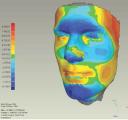The attached document is a summary of the work carried out in the first year of my Phd.
Download: Stereo Vision for 3D Face Recognition (pdf)
 Face recognition is one of the most important and rapidly advancing areas of computer science. Increased recent interest in improving commercial security systems has lead to intensive research into biometric identification and verification applications. Whilst a number of biometrics are potentially available for human recognition the face can usually be captured with the greatest degree of “passivityâ€, thus making it the most suitable choice for general security implementations.
Face recognition is one of the most important and rapidly advancing areas of computer science. Increased recent interest in improving commercial security systems has lead to intensive research into biometric identification and verification applications. Whilst a number of biometrics are potentially available for human recognition the face can usually be captured with the greatest degree of “passivityâ€, thus making it the most suitable choice for general security implementations.
Traditional approaches to the face recognition problem usually attempt identification on the basis of two dimensional data. This approach, whilst partially successful, often proves not to be robust under adverse recognition conditions. Our work attempts to improve upon the accuracy offered by currently available systems by incorporating 3D data into the recognition process. Utilising techniques from multi-view geometry a 3D model of the face is constructed and refined, followed by a recognition stage which utilises both 3D geometry and 2D texture to guide the identification process. In order to successfully achieve these goals a robust 3D capture process is required. Despite the availability of several commercial 3D scanners we propose the development of a system capable of 3D capture with minimal hardware requirements and zero interaction with the recognition subject in order to make the system desirable for a multitude of non-invasive security applications.
At its current stage, the work investigates the fundamental problem associated with stereo vision (multi-view correspondence) and investigates potential solutions. In addition work has been carried out to determine suitable methods for surface construction given an initial point cloud. This work will then be integrated with stereo rig calibration modules and finally with a recognition stage in order to form the complete identification system which will be extensively tested for accuracy against other state of the art systems.